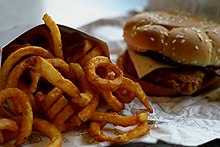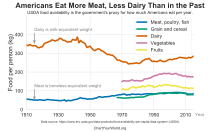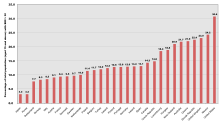Western pattern diet

The Western pattern diet is a modern dietary pattern that is generally characterized by high intakes of
Dietary pattern analysis focuses on overall diets (such as the Mediterranean diet) rather than individual foods or nutrients.[3] Compared to the "prudent pattern diet", which has higher proportions of "fruit, vegetables, whole grains, and poultry", the Western pattern diet is associated with higher risks of cardiovascular disease and obesity.[4]
Elements


This diet is "rich in red meat, dairy products, processed and artificially sweetened foods, and salt, with minimal intake of fruits, vegetables, fish, legumes, and whole grains."[5] Various foods and food processing procedures that had been introduced during the Neolithic and Industrial Periods had fundamentally altered 7 nutritional characteristics of ancestral hominin diets: glycemic load, fatty acid composition, macronutrient composition, micronutrient density, acid-base balance, sodium-potassium ratio, and fiber content.[6]
In 2006 the typical American diet was about 2,200 kilocalories (9,200 kJ) per day, with 50% of calories from
The energy-density of a typical WPD has continuously increased over time. USDA research conducted in the mid 2010s suggests that the average intake of American adults is at least 2,390 kcal (10,000 kJ)[11] per day. Researchers that used different data collection/analysis methods have predicted that the average was about 3,680 kcal (15,400 kJ) per day.[12] By contrast, a healthy daily intake is much lower. Since American adults usually have sedentary lifestyles guidelines suggest 1,600–2,000 kcal (6,700–8,400 kJ) is appropriate for most women and 2,000–2,600 kcal (8,400–10,900 kJ) is appropriate for men with the same physical activity level.
A review of eating habits in the United States in 2004 found that about 75% of restaurant meals were from
Americans consume more than 13% of their daily calories in the form of added sugars. Beverages such as flavored water, soft drinks, and sweetened caffeinated beverages make up 47% of these added sugars.[15]
Americans ages 1 and above consume significantly more added sugars, oils, saturated fats, and sodium than recommended in the dietary guidelines outlined by the Office of Disease Prevention and Health Promotion. 89% of Americans consume more sodium than recommended. Additionally, excessive consumption of oils, saturated fats, and added sugars is seen in 72%, 71%, and 70% of the American population, respectively.[16]
Consumers began turning to margarine due to concerns over the high levels of saturated fats found in butter. By 1958, margarine had become more commonly consumed than butter, with the average American consuming 8.9 pounds (4 kg) of margarine per year.[17] Margarine is produced by refining vegetable oils, a process that introduces trans elaidic acid not found naturally in food.[18] The consumption of trans fatty acids such as trans elaidic acid has been linked to cardiovascular disease.[19] By 2005, margarine consumption had fallen below butter consumption due to the risks associated with trans fat intake.[17]
Vegetable consumption is low among Americans, with only 13% of the population consuming the recommended amounts. Boys ages 9 to 13 and girls ages 14 to 18 consume the lowest amounts of vegetables relative to the general population. Potatoes and tomatoes, which are key components of many meals, account for 39% of the vegetables consumed by Americans. 60% of vegetables are consumed individually, 30% are included as part of a dish, and 10% are found in sauces.[20]
Whole grains should consist of over half of total grain consumption, and refined grains should not exceed half of total grain consumption. However, 85.3% of the cereals eaten by Americans are produced with refined grains, where the germ and bran are removed.[21] Grain refining increases shelf life and softens breads and pastries; however, the process of refining decreases its nutritional quality.[22]
Environmental impact
The transition into a more westernised diet has several implications, particularly regarding the exportation of foods. As populations become more affluent, reflected in a growing GDP, they have more disposable income to purchase food from other countries, which facilitates this dietary transition. This has been observed in many developing nations. In low and middle income countries, this transition is rapid, and this is observed in countries such as Brazil, India, and South Africa. Westernised diets contribute to increasing greenhouse gas emissions. This occurs due to the large global supply chains that food production is a part of. Large areas in Latin America and South-East Asia dedicate a large proportion of their land towards agriculture and forestry, which then gets exported to other countries. This growing use of exports is driving greenhouse gas emissions.[citation needed]
Changing global diets also increase emissions. Increasing per capita incomes leads to urbanisation of a population. When this occurs, populations substitute a low-calorie and vegetable intense diet for more energy-intensive products that are characterised by increase in meat and refined fats, oils and sugar consumption. Once a nation reaches a certain point in development, diet can become the main driver for emissions, particularly when it is focussed on a westernised diet.[23]
Health concerns
Based on preliminary epidemiological studies, compared to a
Crohn's disease
A Western pattern diet has been associated with Crohn's disease.[27] Crohn's disease has its effects on the symbiotic bacteria within the human gut that show a positive correlation with a Western pattern diet.[27] Symptoms can range from abdominal pain to diarrhea and fever.[27]
Obesity

A Western pattern diet is associated with an increased risk of obesity.[28] There is a positive correlation between a Western pattern diet and several plasma biomarkers that may be mediators of obesity, such as HDL cholesterol, high levels of fasting insulin, and leptin.[28] Meta-analyses have also shown that, compared to a healthy diet, a Western pattern diet is linked to increased weight gain among females[29] and adolescents.[30]
Diabetes
Several studies have shown that there is a positive correlation between adoption of a Western pattern diet and incidence of
Cancer
The Western pattern diet has been generally linked to increased risk for colorectal cancer.[32] Meta-analyses have found that diet patterns consistent with those of the Western pattern diet are positively correlated with risk for prostate cancer.[33][34] Greater adherence to a Western pattern diet was also found to increase the overall risk of mortality due to cancer.[35]
No significant relation has been established between the Western pattern diet and breast cancer.[36][37]
Prevalence
In recent years, diets in developing countries such as Mexico, South Africa, and India have transitioned to adopt more elements of the western-style diet. Overall dietary consumption in these regions now reflects a higher balance of processed sugars and fats over lower-calorie food groups like vegetables and starches.[38] In accordance with this pattern, the western-versus-eastern dichotomy has become less relevant as such a diet is no longer "foreign" to any global region (just as traditional East Asian cuisine is no longer "foreign" to the west), but the term is still a well-understood shorthand in medical literature, regardless of where the diet is found. Other dietary patterns described in the medical research include "drinker" and "meat-eater" patterns.[24] Because of the variability in diets, individuals are usually classified not as simply "following" or "not following" a given diet, but instead by ranking them according to how closely their diets line up with each pattern in turn. The researchers then compare the outcomes between the group that most closely follows a given pattern to the group that least closely follows a given pattern.
History

Other area (Yr 2010)[41] * Africa, sub-Sahara - 2170 kcal/capita/day * N.E. and N. Africa - 3120 kcal/capita/day * South Asia - 2450 kcal/capita/day * East Asia - 3040 kcal/capita/day * Latin America / Caribbean - 2950 kcal/capita/day * Developed countries - 3470 kcal/capita/day
The Western diet present in today's world is a consequence of the
See also
References
- .
- PMID 16469985.
- S2CID 6369375.
- ^ PMID 11124751.
- PMID 27559560.
- PMID 15699220.
- PMID 16770923.
- ISBN 978-0-309-08525-0. Retrieved 24 January 2016.
- ^ a b Gary Taubes, Is Sugar Toxic?, The New York Times, April 13, 2011
- PMID 7743394.
- ^ Bentley, Jeanine (January 2017). "U.S. Trends in Food Availability and a Dietary Assessment of Loss-Adjusted Food Availability, 1970-2014" (PDF). USDA.
- ^ Gould, Skye. "6 charts that show how much more Americans eat than they used to". Business Insider. Retrieved 2020-11-06.
- ^ Lobb, Annelena (September 17, 2005). "Eating Habits -- A Look At the Average U.S. Diet". The Wall Street Journal. Retrieved December 1, 2011.
- ^ Philpott, Tom (April 5, 2011). "The American diet in one chart, with lots of fats and sugars". Industrial Agriculture. Grist. Retrieved December 1, 2011.
- ^ "A Closer Look at Current Intakes and Recommended Shifts - 2015-2020 Dietary Guidelines - health.gov". health.gov. Retrieved 2017-08-09.
- ^ "Current Eating Patterns in the United States - 2015-2020 Dietary Guidelines - health.gov". health.gov. Retrieved 2017-08-09.
- ^ a b "USDA ERS - Butter and Margarine Availability Over the Last Century". www.ers.usda.gov. Retrieved 2017-08-09.
- PMID 15699220.
- PMID 24639860.
- ^ "A Closer Look at Current Intakes and Recommended Shifts - 2015-2020 Dietary Guidelines - health.gov". health.gov. Retrieved 2017-08-09.
- ^ "A Closer Look at Current Intakes and Recommended Shifts - 2015-2020 Dietary Guidelines - health.gov". health.gov. Retrieved 2017-08-09.
- ^ "Whole Grains". The Nutrition Source. 2014-01-24. Retrieved 2017-08-09.
- ISBN 978-1-009-15792-6, retrieved 2023-11-22
- ^ PMID 16990408.
- PMID 18574045.
- PMID 29759108.
- ^ S2CID 18672997.
- ^ PMID 15054348.
- PMID 17591599.
- S2CID 21654985.
- PMID 21617109.
- PMID 12578511.
- PMID 27754328.
- S2CID 52308508.
- ^ Entwistle MR, Schweizer D, Cisneros R. Dietary patterns related to total mortality and cancer mortality in the United States. Cancer Causes Control. 2021 Nov;32(11):1279-1288. doi: 10.1007/s10552-021-01478-2. Epub 2021 Aug 11. PMID 34382130; PMCID: PMC8492557
- PMID 27440539.
- PMID 20219961.
- .
- ^ FAO FAOSTAT
- ^ These are supplied energy, intake energy are about 60-80% of supply. FAO estimates food supply of 2700 kcal to be satisfactory.
- ^ FAO Food Security
- ^ PMID 15699220.
- .
Further reading
- Levenstein, Harvey A., 1938- (1988). Revolution at the Table: The Transformation of the American Diet. New York. ). About the changes in dietary advice and eating patterns between 1880 and 1930.
